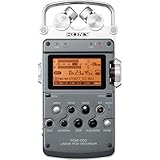
Bottom line: The best professional audio recorder you can buy in its class and you get what you pay for in terms of recording quality, all metal hefty body which withstands elements, high quality in-built microphones, an awesome limiter, everlasting battery life and lastly but not least, needs no operating manual to use.
My experience with build quality: I have ordered this for recording audio while I am shooting video with my Canon mark II 5D camera. I found PCM-D50 is very ruggedly built with all metal body and reassuring heft. I am quite sure this can withstand considerable field abuse like my old Sony Walkman professional. However, I was surprised to found that Sony has not provided any neck strap attaching provision with this recorder. It does have a wrist strap slot, but Sony does to supply that with the recorder too. If you want to securely carry it, you need to buy an optional carry case from Sony! To me the carry case is a must as this is a costly device, which is also too big and heavy to slip in any pocket.
Usability: The recorder is very simple to operate as it has standard audio recorder symbol buttons. Clicking the record button sets the recorder into record pause mode. Pressing the pause button starts and pause the recording, so it is a no brainer to operate.
Level control and Limiter: Recording levels is set by looking at a LCD bar graph and adjusting the Recording Level knob. The optimal level and clipping levels are indicated by two LEDS, this makes the level adjustments very easy. To handle sound with large variation in volume (high dynamic range), this recorder has an inbuilt limiter circuit, which can be turned on by flipping a switch. Once limiter is on, the recorder reduces all transient high volumes to the safe level without producing any clipping. The amazing part is, this limiter does not produce the typical limiter "pumping" effect. Frankly I bought this recorder solely for its wonderful limiter circuit.
In-built Microphones and recording quality: The recorder has two very sensitive and accurate microphones which can be arranged into 90 degree, 0 degree or 120 degree configuration to suit your recording needs. The microphones are so sensitive that they pick up all handling noise and wind noise. In fact the wind noise sensitivity is so high that it is almost impossible to use it without a wind screen over its microphone. Sony has not provided any wind screen with the recorder so that you will have to buy a pricy Sony wind screen AD-PCM1. If you are good in sewing then you can possibly construct one from a piece of artificial fur from a soft toy. All you need to do is to make a small furry bag which fits over the microphone protection cage and it will do the trick. The recorder boasts a signal to noise ratio 93 dB or more, which is excellent. I tested it audibly by cranking the recording level and output volume to maximum with no input at line-in. Even at the super high gain at pre amp and headphone amp stage, my phones were absolutely quite and I could barely hear any faint white noise. That was really impressive. When I have recorded some voice and ambient noise, I was surprised by the super clarity and realism of the recording. I believe I have good ear for recording fidelity and this recorder is the best if I compare it with my other recorders from Olympus, mAudio and Zoom. However I must also say it is not an apple to apple comparison as those recorders are not in the same price range as of Sony PCM-D50.
Tripod mount: As I have said before, the in-built microphones of this recorder is very sensitive and picks up all handling noise. So while recording, keep it resting on a stationary object or mount on a table top tripod. The recorder has a tripod attaching hole at bottom. Sony also sells a wired remote control to further eliminate any noise while pressing buttons to start/stop/pause recording and controlling the recorder from a distance. I have not bought the remote as my application does not need it.
External Microphone: The other way to reduce handling noise is to connect an external microphone through its 2mm stereo jack. It is unfortunate that PCM-D50 does not offer phantom power source or a XLR jack. No wonder as Sony wants you to buy an additional XLR adapter. I have connected a Shure Beta 58A dynamic microphone with the recorder and found the in-built microphone quality is as good as the Shure Beta 58A, so for my application I always use the in-built microphone unless I have to reach very close to the sound source.
Recording media: All audio gets recorded into inbuilt 4GB memory, which can store 1hr55min sound recorded at 96 KHz 24 bit sampling rate. This is more than adequate for my purpose, however the recorder also offers a Memory Stick Pro expansion slot to add more ram is necessary. The recording can be downloaded by connecting the recorder with a laptop or PC through a USB cable. The device gets detected as an external disk drives, and the sound files are located in folders. Just copy the files from the recorder to hard disk and edit it in your favorite DAW.
Pet peeve: There is no in-built speaker; the only way you can listen to the recordings is by plugging in an earphone, headphone or an external amplifier.
Conclusion: PCM-D50 is a wonderful recorder and a must have if you need a high fidelity portable stereo recording device.
Get more detail about Sony Professional Portable 24-bit Linear Audio Recorder.
No comments:
Post a Comment